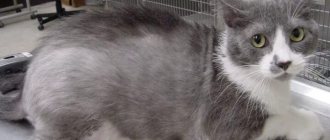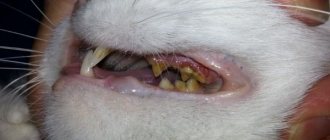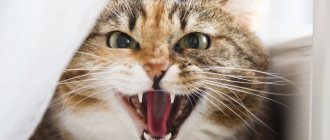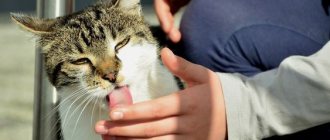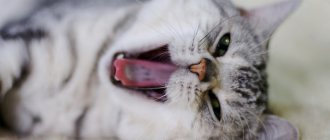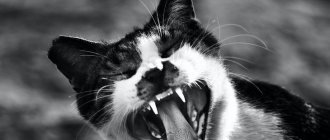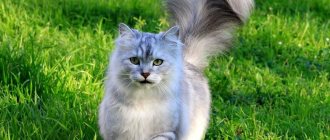8635Administration
3
Any cat lover who has these beautiful creatures living in his home has no doubt noticed how they actively trample with their front paws, diligently massaging their bedding, blanket, or the owner himself. Why a cat tramples with its front paws is of interest to many. There is not a single version that answers this question. They all talk about the natural instincts inherent in the pet from birth.
Having learned more about them, the owner will better understand his furry pet and explain to himself why the cat tramples with its paws. This will allow you to establish the closest relationship with the cat, which will make living in the same house especially interesting.
© shutterstock
A number of false explanations for the seemingly unusual behavior of a pet that tramples with its front paws, and if the owner is guided by them, then he will not be able to understand his pet. In such situations, there is a chance that the relationship with the animal will become strange, and the cat will receive chronic stress from feeling vulnerable and helpless.
It is also unacceptable to punish an animal for its natural behavior, even if the cat is trampling and accidentally stuck its claw at the owner. This is tantamount to scolding a person because, being cold, he begins to shift from foot to foot and shudder. There is an answer to how to change the pet’s behavior if it begins to displease you without causing psychological trauma to the cat. Several recommendations are given in this article; all that remains is to choose one method that is suitable for a particular situation.
A little about cat physiology
For our little friends, the sense of the world is transmitted through many senses of touch. Paws transmit information through receptors and glands, whiskers constantly report the emotions of pets. They are a kind of indicator for the owner, you just need to take a closer look.
After receiving data about the world around them, cats use them in their actions - they release their claws, go to bed, change their place. Depending on the breed and the object of trampling, you can understand why domestic cats purr and move their paws.
From a scientific point of view
"Milk step" is a term used in veterinary medicine to describe the behavior of a kitten when it receives milk from its mother. Kittens tend to massage the belly of a nursing cat, thereby stimulating milk production in the adult animal.
It is believed that when cats purr and move their paws, they fall into childhood. After all, the memory of one of the earliest and most pleasant events in an animal’s life remains in its subconscious forever. In addition, when stomping in one place, accompanied by purring, quiet smacking is often heard.
It is also known that animals separated from their mother early massage a soft blanket or blanket much more often than those who spent the required time with the cat.
A situation where a cat often moves its paws on its owner’s body means that he trusts him and feels comfortable in his presence. The animal does not feel fear, it is caressed, protected, well-fed and grateful. This behavior of the pet indicates that he is attached to the person as to his own mother.
When this phenomenon occurs
Animal psychologists identify two reasons for trampling: instincts and a manifestation of love for the owner.
Instincts include actions when cats:
- mark territory (sweat glands on paw pads);
- getting ready for bed (checking for comfort);
- during the period of heat (trying to attract attention).
But there are also conscious reasons why they can stagnate:
- show their devotion;
- have a healing effect on themselves or the owner;
- for the sake of obtaining the pleasure hormone - endorphin.
Why do cats trample their paws and purr?
Why a cat tramples its paws: the main reasons and what it means
A cat massages its paws - what does this mean? There is no exact interpretation, but scientists and simply cat lovers put forward several interesting versions. Each one undoubtedly deserves attention.
- Psychological release. It has been scientifically proven that cats are more stressed than humans. This condition can be provoked by many external factors: unusual surroundings and unfamiliar people, loud music or the appearance of another animal in the neighborhood. To relieve nervous tension, a massage cat awakens in the pet. He comes to his owner and begins to trample him with his paws.
- Behavioral instincts. The behavior of animals in the vast majority of cases is determined by instincts. The fact is that their ancestors hunted themselves and arranged a place to spend the night. So, in order not to sleep on a hard surface, the cats trampled the earth and grass with their paws. And even after hundreds of years, the instinct was not lost.
- Rhythmic movements of the front paws are also often called milk steps. Every person at least once in his life has seen how little kittens feed. This is how they tell their mother that they are full and satisfied. Animals retain these memories for their entire lives.
- Designation of territory. Scientists suggest that the cat massages people, blankets and other surfaces with its paws in order to clearly indicate its possessions. The fact is that animals have sweat glands on their paw pads. They release a secretion with a specific odor that a person cannot smell. But this does not prevent cats from understanding each other in this way.
- If a cat gives a massage, then this is a manifestation of pleasure and love. Many cat owners are convinced that paw massage is a manifestation of love and the highest degree of trust.
- Mating season. A cat or cat may begin to actively move its front paws with the beginning of the mating season. If there is no potential partner nearby, the animal switches to its owner and other household members it loves.
Cat massage
There is another widespread theory - an animal tramples its owner when it wants to improve his physical and psycho-emotional state. Sometimes people’s pain actually goes away due to the rush of blood to the place where the caring pet is trampling. There are several solutions to the problem - be patient and wait it out, find a friend for your pet, or have it spayed/neutered.
Note! Releasing claws and trampling are always, without exception, a manifestation of positive emotions, so you should not shout at your pet if she is scratched, you need to show your concern in return.
What cats don't trample on humans?
If a cat moves its front paws, sometimes releasing its claws, in professional language this is called a “milk step”. The name refers to a certain fact about kittens: when babies “walk” on their mother's belly, they speed up the flow of milk to the nipples. This association lasts throughout life; kneading with paws is safe and healthy.
Lack of instinct is not due to breed, color or other general factor. Most often, this manifests itself in artificially raised kittens that have lost their mother and were fed from a pipette. It is a little less common for a mother cat to have a lot of milk. In both cases, the little pets did not need to crush the mother’s belly with their paws and get milk for themselves, so they do not show the characteristic instinct at a conscious age.
But this does not mean that the kitten will grow up “somehow different” or will love you less!
Kitten crumples a toy with its paws
Main reasons
Many cat lovers have noticed similar behavior in their pets. Animals trample on the laps or chests of their owners, as if kneading dough. Some believe that this is how cats massage and even treat people. But if this is so, then why do they knead the bed with their paws? What do these feline movements really mean? We invite you to understand this interesting phenomenon in more detail.
Physiology of cat paws
Cats have a huge number of points on their limbs that form their tactile sensations. It is with its paws that the cat “tests the world” - it crushes and touches various objects, learning about its environment. For example, before stretching out in all its glory on the sofa, your pet will definitely walk around it length and breadth and find the most pleasant place.
There are many glands on the pads of the feet, including sweat glands. This has a very specific purpose - not to scare off the prey with the smell spreading from the body. Scent trails contain a lot of useful information: who they belong to, for whom they are dangerous, and for whom they are a mating signal. In general, if your pet crushes its owner or an object that has fallen under its paws, this thing is already marked and, according to the laws of the jungle, does not belong to you.
Pet's childhood memories
This unusual movement, otherwise called the “baby step,” first appears in childhood. Kittens sucking their mother's milk, relaxing and stretching out their paws, massage the nipple slightly, releasing their claws, this way the secretion of milk is stimulated. At these moments, being next to their mother, they feel completely safe, they are warm, nourished and comfortable.
Being already adults and feeling security and contentment, cats can “relapse into childhood” and knead their owner’s knees, like they once did with their mother’s belly. This version is also supported by the fact that sometimes the “milk step” is accompanied by a quiet smacking of the lips. It has also been noted more than once that animals that are taken from their mother too early exhibit similar behavior more often, as if trying to compensate for what they lost in childhood.
Reasons for this behavior
To better understand their pet, caring owners study the behavior of the animals, try to understand what it means and benefit from living together. Therefore, the main reasons for their behavior have long been known:
Recognition of the owner by mom
My warmest childhood memory is my mother's love. When kittens knead with their front paws, they return to the childlike state of calm and tranquility that they felt next to their mother-nurse. They purr and stomp around - this means they show devotion and communicate in the language of cats that they trust us.
Relieving emotional stress
The cat tramples the blanket
Just like humans have on their fingers, cats have many receptors on their paw pads that are responsible for tactile sensations. To relieve stress after a trip to the veterinarian or to cope with lack of attention during the day, cats perform their own ritual - trampling soft surfaces. Belly, blanket, bedding, sofa. The cat experiences emotional release due to the release of endorphins from a pleasant surface for the pads.
If you interfere with therapy, you may get a bite or other aggressive response.
Endorphin is a pleasure hormone that helps animals reduce their pain. This is especially noticeable in the lives of pregnant cats, who spend a lot of time trampling down the blanket. This way they reduce the suffering from contractions and calm down, entering a trance from the monotonous action.
If an animal paws too hard without making sounds, it is likely feeling resentful. Resentment for the raised tone, harsh action, unsatisfied demand for sausage from the table. With the help of rhythmic steps on a soft surface, they “let off steam.”
Preparation for sleep
The instinct to prepare for sleep can be associated with the wild relatives of domestic animals. It goes back a long way, so we can definitely answer the question of why a domestic cat tramples a blanket with its front paws.
To prepare a place to sleep, wild animals crush the hard grass underneath them, driving insects out of it, making their overnight stay safe. A pre-trodden place means its convenience and coziness. For modern cats, the purpose of trampling is exactly the same - to check comfort and safety.
The cat tramples the blanket
Therapeutic effect
An obvious benefit from cat attention is massage. If the cat is comfortable with you, he will try to lie on his knees, stomach, back or other surface, massaging it for a long time. This improves blood circulation, warms up the muscles, and together with the purring creates a wonderful calming effect for the owner.
You heard about another theory of the therapeutic effect from folk superstitions. Cats feel negative energy, so they try to lie down in the same place to take away the pain or, conversely, to indicate an approaching disease. After the “massage session,” the cat curls up into a ball to fall asleep and warm the prepared area.
If your pet often lies down on its legs, it may be worth checking the joints.
But you shouldn’t take this folk wisdom to heart. Most likely, the pet simply expresses its gratitude and wants to share the pleasure hormone through stomping.
Why does a cat trample with its paws?
Cats can give massages not only to their owners. Animal neighbors with whom they are on good terms also receive this kind of attention. Experienced owners note that for the sake of such a massage, dogs will even endure clawed paws.
Genetics and territory marking
There is another reason related to instinct. Felines have sweat glands on their paws rather than on their bodies. This feature applies to all predators, so they can monitor their prey so as not to scare it off with their smell.
Today, with the help of sweat glands on their paws, pets mark territory and objects that belong to them. Therefore, most often they crumple already favorite places.
Any object can be marked as property. Cats eat a place to sleep: a sofa, a pillow, a blanket, a blanket, a bed. They trample their owners, leaving barely noticeable odorous substances behind their pads. They crush furniture, clothes, and favorite toys, marking their territory so that rivals do not dare to lay claim to it.
The cat trampled down the place to sleep
A similar instinct applies to cats, as cats mark their territory by spraying odorous secretions onto objects on their property.
Other reasons
During the mating season, pets become extremely loving. They rub against their legs, show various signs of attention and, of course, massage everything around with their paws. This behavior, according to many scientists, is associated with unrealized sexual instinct.
This type of trampling has its own characteristics. Females climb onto a sofa or bed, arch their backs and trample with their hind paws rather than their front paws. This usually lasts until pregnancy occurs or a couple of weeks if pregnancy does not occur.
Cat during mating season
In this type of trampling, males hold the cover with their teeth. But unlike cats, they can behave this way at any time. Only when the period of physiological arousal subsides will the pet return to its normal state.
Other reasons
In addition to the childish instinct from the memory of kittens and a therapeutic massage session, the cat may have several other reasons for trampling. The pet most often kneads and tramples a blanket or blanket made of natural wool with its paws, which has a characteristic smell; animals also massage natural woolen sweaters. Animal psychologists are inclined to believe that the kitten (and kneading fur is most typical for babies) simply likes the smell of the products, maybe it reminds him of the warmth and aroma of his mother’s fur.
Preparation for sleep
An animal can treat something like this on which it plans to lie down to sleep.
If a cat stomps with its front paws on clothes, a blanket or a bed, this means that the pet has chosen a place to sleep and is preparing a bed for itself. At a time when cats slept in the open air, they paved a bed for themselves from fallen leaves, hay, and trampled down grass to make the bedding soft and comfortable, protecting them from the cold. In order to make themselves more comfortable, pets behave like their ancestors: they knead soft things and bedding. You can often see a cat trampling on the owner’s blanket and pillow. If you don't drive it away, it will settle down for the night next to a person's head or legs. This makes the animal feel safe.
To attract attention
Another reason why a cat crumples a soft blanket or clothes with its paws is an attempt to attract attention and flirtation. It is not difficult to recognize this meaning in behavior: if a pet jumps off when the owner approaches, runs to another place and there they repeat the “trampling ritual” - it means he is inviting you to play with him or wants to convey something to the person’s attention.
The owner’s actions, should I scold?
It's always nice to feel mutual affection from a pet. But this is exactly how you should define his trampling of your body. Therefore, even if the claws hurt you, do not scold the animal. During the moments of their therapy, they are at the peak of calm and goodwill, purring loudly, showing love in every possible way. The four-legged simply will not understand why they are shouting at him. In the worst case, he will lose confidence in the owner.
Releasing claws is an instinct. The cat won't notice how it hurts you. The right move is to lightly touch the clawed paw and stroke it so that he hides them back.
There are a couple more tricks that will help you avoid claws:
- discreetly place a thick blanket or jacket under your paws, then continue to enjoy the massage;
- With calm stroking, lull him to sleep and lay him on his side so that he cannot move his paws;
- distract him with any toy, so he will forget about trampling for a while.
How to stop a cat when it paws
Veterinarians also recommend trimming their nails in a timely manner and monitoring their health.
What not to do when your cat gets too carried away and shows her claws
- Do not Cry
- Don't hit
- Don't push away
These animals react poorly to sharp sounds. If you scream, use physical force, or react sharply to your pet’s actions, it can suffer severe stress. This will certainly be followed by unpleasant consequences: he will avoid tactile contact, begin to spoil personal belongings, or mark territory where you do not want him to be.
Such actions will only create a gap between you. But a pet is a source of endless devotion, gratitude and positive emotions.
If distraction techniques do not work, you should accustom the cat to the scratching post, thereby instilling an association: where it is possible to let out its claws and where it is not. For this we recommend:
- Determine, then prepare the site. Observe which spot he currently uses to sharpen his claws and use that. It is better to secure the remaining items.
- Get your pet interested in using the scratching post. Place toys nearby and spread catnip on them.
- Encourage the right actions. Everything from petting to delicious food is suitable here. The main thing is to consolidate the positive emotion.
The benefits of communicating with a cat
Why does a cat trample with its paws?
If the owner knows how to listen to the desires of his pet and feels this subtle emotional connection with him, he can get a significant positive return.
- Stroking the fur reduces stress levels and creates a feeling of relaxation. If you suffer from insomnia, pet your cat for 15 minutes before going to bed. This will calm you down, which will speed up the process of falling asleep and improve the quality of your sleep.
- A responsible owner is not at risk of long-term depression or protracted disorders. It’s enough to feed the cat, pet it, and slowly but surely you come back to life.
- Studies among pet owners have also shown that such people are less likely to feel loneliness and experience loss more quickly.
- Conversations with a domestic animal are no longer strange. And American scientists have proven that cat owners lead a more social lifestyle than people without them.
- The purring and warmth of the cat has a positive effect. And here we are talking not only about the psychological state, but also about the body as a whole. When a cat lies on your body for a long time, it warms it. This in turn lowers blood pressure, relieves muscle spasms, and reduces pain in the affected area.
- A cat massage is the pet’s most sincere attempt to share endorphin hormones (the pleasure hormone). Let it trample you and soon you will feel a surge of joy.
The cat's stomping is inextricably linked with his good intentions. Exchange signs of attention with your pets, and they will thank you for it more than once!

